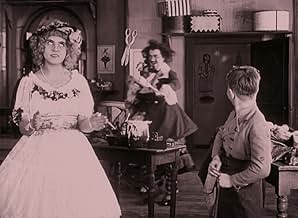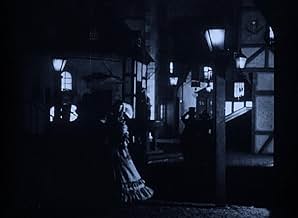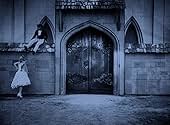IMDb-BEWERTUNG
7,4/10
2576
IHRE BEWERTUNG
Der schüchterne Lancelot soll Puppe heiraten. Ossi zerbricht sie und stellt sich an ihre Stelle.Der schüchterne Lancelot soll Puppe heiraten. Ossi zerbricht sie und stellt sich an ihre Stelle.Der schüchterne Lancelot soll Puppe heiraten. Ossi zerbricht sie und stellt sich an ihre Stelle.
Ernst Lubitsch
- Director in Prologue
- (Nicht genannt)
Empfohlene Bewertungen
People speak of the Lubitsch Touch first showing up in THE OYSTER PRINCESS, but that movie always struck me me as a a good romantic comedy, dimmed by changes in fashion, creaking a bit in age.
But this movie is the real thing: a silly story told with much flair and constant surprises. It begins with Lubitsch showing you a model of the set, like Penn and Teller showing you how they do the cup-and-ball trick, followed by a show that dazzles you: pantomime horses, venal monks and a little bit of E.T.A. Hoffman all fall under the thrall of Lubitsch and all of them, and the audience too, end up with smiles on their faces.
This movie is too good to more than hint at its wonders. If you have never seen a silent feature, see this one.
But this movie is the real thing: a silly story told with much flair and constant surprises. It begins with Lubitsch showing you a model of the set, like Penn and Teller showing you how they do the cup-and-ball trick, followed by a show that dazzles you: pantomime horses, venal monks and a little bit of E.T.A. Hoffman all fall under the thrall of Lubitsch and all of them, and the audience too, end up with smiles on their faces.
This movie is too good to more than hint at its wonders. If you have never seen a silent feature, see this one.
Because the Baron of Chanterelle wants to preserve his family line, he forces his timid nephew Lancelot to choose one of the village maidens to wed. Lancelot flees to a monastery to escape the forty eager maidens. When the gluttonous monks discover that the Baron is offering a large sum for the marriage, they suggest Lancelot marry a mechanical doll instead.
I absolutely love how this was put on as a mixture between a play and a film. Some of the sets (such as inside the castle) seem quite elaborate, while other things (the trees and horses) smack of a high school production. But not in a bad way -- there is a certain charm to how this story unfolded. Add to that the wild hair and outfit of the puppet master (a precursor to Willy Wonda) and you have a great looking film.
Something could be said about the interaction between people and robots, and at what point are robots so lifelike that the line between human and non-human is all too fuzzy. But this is a light-hearted film and I will not get too serious here.
I absolutely love how this was put on as a mixture between a play and a film. Some of the sets (such as inside the castle) seem quite elaborate, while other things (the trees and horses) smack of a high school production. But not in a bad way -- there is a certain charm to how this story unfolded. Add to that the wild hair and outfit of the puppet master (a precursor to Willy Wonda) and you have a great looking film.
Something could be said about the interaction between people and robots, and at what point are robots so lifelike that the line between human and non-human is all too fuzzy. But this is a light-hearted film and I will not get too serious here.
Such a charmer. It certainly feels like a Lubitsch film, as it pushes boundaries with sex but in a playful way, makes cheeky observations about human behavior, and has entertaining characters skating along in a light comedy. Pretty impressive, especially for 1919, and well worth 66 minutes.
Some of the bits I liked:
Some of the bits I liked:
- Seeing Lubitsch himself as the film begins, setting up the doll house which the characters then inhabit.
- The performances from Ossi Oswalda (the daughter/doll) and Gerhard Ritterband (the young apprentice). Oswalda's facial expressions and body control as the doll are wonderful, and Ritterband imitations of his boss were amusing. I also chuckled when he kisses his boss's wife after having kissed the doll, "Just so no one feels neglected," and how he later says he's throwing himself out the window out of shame, only to slide out easily from the first story.
- The artistry in the set designs, which while not boldly Expressionistic, have quite a flair, making the film a treat visually. You also get a couple of clearly fake horses, little effects like a montage of close-ups of chattering mouths, a transparency during a dream sequence, and a man's hair turning white when he gets shocking news.
- The doll being advertised as follows: "Offered to bachelors, widowers, and misogynists! I have succeeded, with the help of a mechanism I built, in constructing a human-like doll who can walk, dance, and sing by pushing different buttons." And as an aside, the toymaker has designed it to look like his daughter, even though it's a short leap to think of it as a sex doll being peddled to lonely (and abusive?) men, how creepy is that?
- The priests chowing down food like pigs, not wanting to share, and then finagling their way into getting their hands on the boy's dowry. One of them later ogles the "doll's" legs while she's dancing.
- The family members arguing over possessions before a loved one has even passed away, breaking a vase in the process.
- How the guy who is afraid of girls goes from being chased all over town by 40 young women who all want to marry him to being in the showroom at the dollmaker's, confronted by (probably 40, the same 40) dolls who all hop over to him eagerly, nodding their heads.
- The various innuendo once the young man does take possession of what he thinks is a doll. The toymaker tells him "Don't forget to oil her every two weeks." His father asks him whether he wants any last advice before leaving for the first night of his marriage, to which he replies "No thanks, I have an instruction manual." Oh my goodness, if this isn't classic Ernst Lubitsch, I don't know what is.
This comedy from the hands of Ernst Lubitsch in 1919 is a joyride through a number of imaginative sets and situations. Even though its artificiality if ever apparent, the movie makes it work by playing with the costumes and sets, to create a whimsical world where everything can happen.
Like other Lubitsch films the plot of this is build upon similar themes such as facade and identity. Although not my favourite of Lubitsch's films it hold a place in the top five. This movie is assured to put a smile on your face the whole way through, driven by Lubitsch's at times expressive directing.
Like other Lubitsch films the plot of this is build upon similar themes such as facade and identity. Although not my favourite of Lubitsch's films it hold a place in the top five. This movie is assured to put a smile on your face the whole way through, driven by Lubitsch's at times expressive directing.
'The Doll', directed by Ernst Lubitsch, is a charming fantasy, a splendidly original film inspired by one of the Tales of Hoffmann ... and a movie which also captures the mood of English holiday pantomimes and Hans Christian Andersen. As a bonus, this film features an extremely kinky performance (very funny and sexy at the same go) by the delightful actress Ossi Oswalda.
In the opening shot we see the great Lubitsch himself, setting up a doll's house against a stylised backdrop. A close-up of this model then dissolves into a full-sized version of the same stylised setting, from which emerge actors dressed as dolls. From this point onward, the entire film is staged on highly stylised sets ... much like 'The Cabinet of Dr Caligari', except that these sets are bright and airy.
Old Baron Chanterelle has no family except for his gormless nephew Lancelot. To continue the line, the Baron offers his nephew a dowry of 300,000 francs to get married. But Lancelot is afraid of women. The local prior shows him an advertisement from the dollmaker Hilarius, who offers a special service 'for bachelors, widowers and misogynists': a life-size clockwork girl! Lancelot decides to marry the mechanical bride, collect the dowry, then stash the doll in the attic.
Hilarius, for some reason, has made his clockwork doll an exact duplicate of his pretty daughter Ossi (anticipating a similar plot device in the 1949 film 'The Perfect Woman'). The clockwork girl has a control panel on her back (like Julie Newmar in 'My Living Doll') and a crank to wind her up.
The real Ossi decides to do some winding up herself: playing a joke on Lancelot, she attaches the control panel and the handcrank to her own back and pretends to be the doll. Of course there are problems when the 'doll' sneezes or coughs, and eventually Ossi gets hungry and thirsty because nobody offers the doll any refreshments. (How does she handle toilet breaks?)
In a frilly outfit with a short skirt, Ossi is very pretty as both the mechanical girl and the real one. There is some surprisingly good double-exposure in a couple of camera set-ups when the real Ossi and the mechanical one are onscreen simultaneously. Brilliant camerawork throughout by the great Theodor Sparkuhl.
Remarkably, Lancelot goes from the wedding banquet to the bridal chamber without ever twigging that his clockwork bride is the genuine article. (We don't see the wedding itself; perhaps Lubitsch feared that audiences would be offended by the idea of a man exchanging wedding vows with an inhuman object ... and in fact, an insert shot of a wedding certificate establishes that the wedding was a civil ceremony, not a religious one.)
The great charm of this film is its mood of fairy-tale unreality. The coachman's horses are played by men in pantomime-horse costumes. A cat and a rooster are played by cut-out figures. The moon has a human face, looking rather too much like Oscar Levant! I enjoyed a bizarre scene in which an entire roomful of mechanical girls dance for Lancelot.
There's also a remarkable early example of pixilation (stop-action animation using actors rather than mannequins) in a gag sequence in which Hilarius's hair stands on end, then turns white.
The sequences of Ossi (the real one) dancing stiffly while pretending to be a clockwork girl remind me of the sequence in 'Metropolis' when the female robot takes her first awkward steps. (Could this film have influenced 'Metropolis'?) A comedy sequence in this film prefigures a similar sequence in Buster Keaton's 'Seven Chances', when forty women bent on matrimony pursue Lancelot through the streets.
'The Doll' is an absolute delight from beginning to end, a film that the entire family will enjoy. I regret only that the German intertitles were set in a Fraktur typeface which made them very difficult to read. I'll rate this delightful movie 10 out of 10.
In the opening shot we see the great Lubitsch himself, setting up a doll's house against a stylised backdrop. A close-up of this model then dissolves into a full-sized version of the same stylised setting, from which emerge actors dressed as dolls. From this point onward, the entire film is staged on highly stylised sets ... much like 'The Cabinet of Dr Caligari', except that these sets are bright and airy.
Old Baron Chanterelle has no family except for his gormless nephew Lancelot. To continue the line, the Baron offers his nephew a dowry of 300,000 francs to get married. But Lancelot is afraid of women. The local prior shows him an advertisement from the dollmaker Hilarius, who offers a special service 'for bachelors, widowers and misogynists': a life-size clockwork girl! Lancelot decides to marry the mechanical bride, collect the dowry, then stash the doll in the attic.
Hilarius, for some reason, has made his clockwork doll an exact duplicate of his pretty daughter Ossi (anticipating a similar plot device in the 1949 film 'The Perfect Woman'). The clockwork girl has a control panel on her back (like Julie Newmar in 'My Living Doll') and a crank to wind her up.
The real Ossi decides to do some winding up herself: playing a joke on Lancelot, she attaches the control panel and the handcrank to her own back and pretends to be the doll. Of course there are problems when the 'doll' sneezes or coughs, and eventually Ossi gets hungry and thirsty because nobody offers the doll any refreshments. (How does she handle toilet breaks?)
In a frilly outfit with a short skirt, Ossi is very pretty as both the mechanical girl and the real one. There is some surprisingly good double-exposure in a couple of camera set-ups when the real Ossi and the mechanical one are onscreen simultaneously. Brilliant camerawork throughout by the great Theodor Sparkuhl.
Remarkably, Lancelot goes from the wedding banquet to the bridal chamber without ever twigging that his clockwork bride is the genuine article. (We don't see the wedding itself; perhaps Lubitsch feared that audiences would be offended by the idea of a man exchanging wedding vows with an inhuman object ... and in fact, an insert shot of a wedding certificate establishes that the wedding was a civil ceremony, not a religious one.)
The great charm of this film is its mood of fairy-tale unreality. The coachman's horses are played by men in pantomime-horse costumes. A cat and a rooster are played by cut-out figures. The moon has a human face, looking rather too much like Oscar Levant! I enjoyed a bizarre scene in which an entire roomful of mechanical girls dance for Lancelot.
There's also a remarkable early example of pixilation (stop-action animation using actors rather than mannequins) in a gag sequence in which Hilarius's hair stands on end, then turns white.
The sequences of Ossi (the real one) dancing stiffly while pretending to be a clockwork girl remind me of the sequence in 'Metropolis' when the female robot takes her first awkward steps. (Could this film have influenced 'Metropolis'?) A comedy sequence in this film prefigures a similar sequence in Buster Keaton's 'Seven Chances', when forty women bent on matrimony pursue Lancelot through the streets.
'The Doll' is an absolute delight from beginning to end, a film that the entire family will enjoy. I regret only that the German intertitles were set in a Fraktur typeface which made them very difficult to read. I'll rate this delightful movie 10 out of 10.
Wusstest du schon
- WissenswertesAt one point Lancelot takes a heart out of the leg of his pants. This is an allusion to the German expression 'Das Herz ist mir in die Hose gerutscht' (my heart slid into my pants) which is equivalent to 'to have one's heart in one's boots'.
- PatzerLancelot shouts his alarm to a monk that he is being pursued by "40 women". However, about 20 women are seen on screen.
He says this because the butler earlier had announced "Forty women at the door!" It's an estimate as it's doubtful the butler made an individual count. Also, there is no "requirement" that all referenced individuals must appear on screen.
- Zitate
Baron von Chanterelle: [on Lancelot's wedding night] Do you need any more pieces of advice?
Lancelot: No thanks, I have an instruction manual.
- VerbindungenFeatured in Kino Europa - Die Kunst der bewegten Bilder (1995)
Top-Auswahl
Melde dich zum Bewerten an und greife auf die Watchlist für personalisierte Empfehlungen zu.
- How long is The Doll?Powered by Alexa
Details
- Laufzeit
- 1 Std. 6 Min.(66 min)
- Sound-Mix
- Seitenverhältnis
- 1.33 : 1
Zu dieser Seite beitragen
Bearbeitung vorschlagen oder fehlenden Inhalt hinzufügen


























